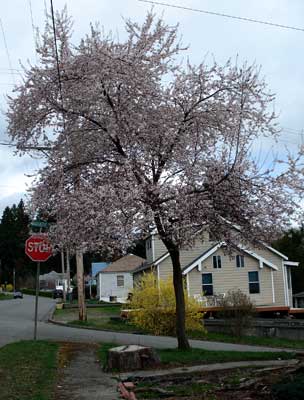
Pissard's Purple-leaf
Cherry Plum
"What is more mortifying than to feel
that you have missed the plum for
want of courage to shake the tree?"
-Logan Pearsall Smith
(1865-1946)
Every day when I walk Daigoro, singing for him, "Pissing on your favorite post/ That's the one you like the most/ Pissing on your favorite post is such a lot of fun," there are numerous trees & perennials I keep an eye on as though they were in my own garden, since it's my own neighborhood.(1865-1946)
Two blocks down at the stop-sign is a little house which has in its front yard, on the edge of the sidewalk, a purple-leaf cherry-plum, Prunus cerasifera variant atropupurea 'Pissardii.' It's marketed variously as 'Atropurpurea,' "Pissardii,' the Pissard Plum, Purple-leaf Myrobalan, or Black Cherry Plum.
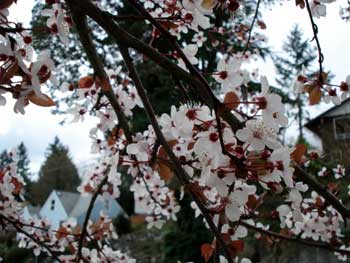 It got the name 'Pissardii' when introduced into France in the 1880s by a certain Monseiur Pissard, who had obtained the first specimens from the Shah of Iran, whom M. Pissard served as chief gardener. But since even M. Pissard's first name seems to be unknown, it hasn't remained a significant cultivar name, & it's much better known as 'Atropurpurea.'
It got the name 'Pissardii' when introduced into France in the 1880s by a certain Monseiur Pissard, who had obtained the first specimens from the Shah of Iran, whom M. Pissard served as chief gardener. But since even M. Pissard's first name seems to be unknown, it hasn't remained a significant cultivar name, & it's much better known as 'Atropurpurea.'In New England & elsewhere through the United States, the most common cultivar has been 'Thunder Cloud' or 'Nigra' which have pink blossoms. Here in the Northwest we typically have 'Mt. St. Helens' with blooms a very faint pink.
The original 'Pissardii' aka 'Atropurpurea' is the one with nearly pure white flowers, really taking a very close look to notice the faintest blush of pink. 'Vesuvius' is a rare variant encountered mainly in northern California; it has very white blooms, a much smaller stature, & is not as flowery or fruitful.
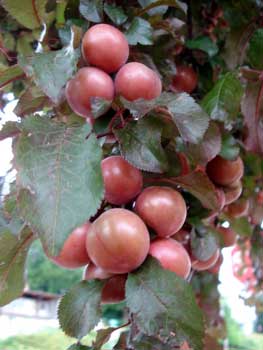 One sees either the original 'Atropurpurea' or its subsequent cultivars all around Seattle & Tacoma streets (as well as everywhere in Idaho & Oregon). It's frankly a bit over-used; but it is much more reliably healthy than the equally overused pink flowering Japanese cherry, plus it has the bonus of very good fruits, providing large harvest even from a single tree.
One sees either the original 'Atropurpurea' or its subsequent cultivars all around Seattle & Tacoma streets (as well as everywhere in Idaho & Oregon). It's frankly a bit over-used; but it is much more reliably healthy than the equally overused pink flowering Japanese cherry, plus it has the bonus of very good fruits, providing large harvest even from a single tree.As a species variant rather than a grafted cultivar, 'Atropurpurea' in the main grows true from seed, though it's usually reproduced from cuttings. When birds drop seeds in backyards, these are apt to take hold in regularly watered gardens.
Since seed-grown specimens are uncommon, it is worth preserving one when this happens. Pot it carefully without disturbing the young roots, & baby the seedling for a couple years, then plant the sapling in a perament location.
Production trees, alas, are needlessly grafted, presumedly to make them hardier on the toughest rootstocks, but really just to hasten production. Grafted specimens often sucker badly so I'd recommend a specimen with its own roots, or none at all. A cutting that has gotten started with rooting hormone instead of grafting is the perfect clone.
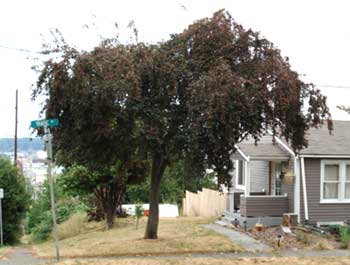 The Pissard plum is a natural dwarf rarely exceeding twenty feet in height. Taller is possible, but it is additionally shortlived, showing signs of old age in a scant twenty years.
The Pissard plum is a natural dwarf rarely exceeding twenty feet in height. Taller is possible, but it is additionally shortlived, showing signs of old age in a scant twenty years.A forty year old tree is not improbable, but it may well be useful as a snag only. A weak or dying old tree, if not apt to fall on anything important, can be an excellent feature of the garden. The Pissard plum in particular will flower beautifully to the bitter end, never losing its gorgeousness until the day a windstorm or heavy winter icing brings it down.
An aged fruit tree with rotting heart attracts more wildlife than does a young healthy tree because it provides housing options for birds & flying squirrels, insects for woodpeckers, & such like. No one should ever be too hasty to remove a tree just because it's reaching the end of its life, as it can be a marvel to see more of what nature does during the complete life cycle & slow decline of a single tree.
This specimen I've observed for a decade & it was full grown ten years ago. I presume it's around twenty, though it has not shown any signs of decline as yet.
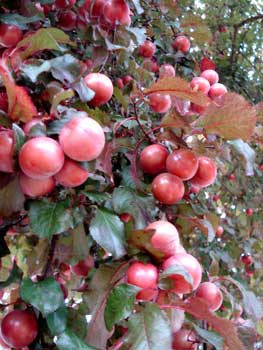 It has dark-chocolate bark & dark purple leaves, the leaves holding their color all spring & much of summer. It becomes bronzy-green toward summer's end when fruit is ripest, but this is temporary, as it soon turns back to purple for autumn. Often alleged to have minimal winter interest, I actually find this oldish specimen very interesting year-round. The very dark bark & limb structure looks great against a winter sky.
It has dark-chocolate bark & dark purple leaves, the leaves holding their color all spring & much of summer. It becomes bronzy-green toward summer's end when fruit is ripest, but this is temporary, as it soon turns back to purple for autumn. Often alleged to have minimal winter interest, I actually find this oldish specimen very interesting year-round. The very dark bark & limb structure looks great against a winter sky.In March it begins flowering fragrantly before leaves emerge, but leaves are swift to arrive while blooms are still fresh. At first the unfolding leaves are blood-red, but soon darken through red-brown to purple-black.
For Puget Sound weather (Zone 7/8) this is an extremely hardy plum, only rarely showing any sign of disease. But it is marketed from zones 3 to zone 10 (though 5 to 9 would be stretching it). In some regions it proves more delicate, with reports of Japanese beetle, borer, tent-caterpillar & aphid attack, limb dieback from winter damage, & sundry diseases such as leaf-spot & canker.
The purple-red fruit is the size of a very large cherry (or a cherry-bomb), perfectly round. It is not the sweetest of plums but tasty nonetheless, & ideal for jams with the tough skins as well as the pits sieved out.
This tree is fruitful to extreme with each limb just loaded with plums. The owner of the house never harvests them but children harvest the lower limbs & so do Granny Artemis & I, a handful now & then, in July & August, since they're rather long-lasting on the branches. There is considerable mess on the sidewalk when the cherries start falling, which anyone planting one should bare in mind when deciding on placement.
It likes regular watering in summer but gets plenty of water from rainfall the rest of the year around here. It requires very little in the way of pruning, though when young it should be pruned while developing to insure a strong trunk & so it will not too soon be too tall for easy harvesting